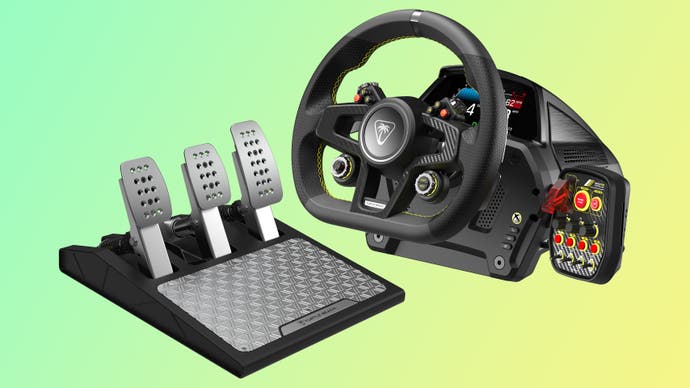Turtle Beach VelocityOne Race review: direct drive racing wheels go mainstream
Capable, affordable and feature-rich - with a few rough edges.
The Turtle Beach VelocityOne Race is a complete racing wheel and pedals of the sort that you'd expect to find in a mainstream electronics boutique alongside Logitech's ubiquitous G29, yet it offers a powerful 7.2Nm direct drive wheelbase and more realistic load-cell brake pedal, features that often set apart more enthusiast-grade sim racing offerings. Have Turtle Beach played a blinder here to deliver that desirable combo - complete with an external control pod, big integrated display and Xbox/PC compatibility - for £629/$650? Yes, but there are caveats.
Let's start at the beginning. Taking the whole kit and caboodle out of the box, you can see from the off that the design is designed to be a little more approachable than more boxy and industrial efforts from enthusiast firms like Fanatec or Moza, with a more rounded wheelbase that sports not only a large (five-inch) digital dashboard but also a smart fastening system. Two little arms drop out of the bottom of the base with the aid of a provided allen key, and then retract to mount on to a desk with considerable strength.
There's room on either side for the allen key to be stored in the wheelbase too, so you can make further adjustments even if you're sat down at the wheel without having to keep tools nearby. You can use the same tool to attach the included control pod on either side of the wheel, giving you access to a higher button count than I've seen on most wheels of this price range.




The pedals are also designed to be easily usable without hard-mounting them onto a racing cockpit or similar, with a choice of knobbly or flat sticky pads for the pedal base that can grip on to carpet or tile respectively. I'd still recommend a proper mount if you can swing it, but with these pads in place and the load cell brake set to a high sensitivity, you at least have a chance of the pedals remaining in the same room when you brake for a hairpin turn.
It's nice to see that you get a full three pedal set here, with clutch, brake and accelerator, and there's a decent range of adjustability - you can fold down the clutch pedal if it goes unused in your games of choice (eg the F1 titles), adjust the force required to press the clutch or accelerator, and change the spacing between each pedal a tad too. However, you can't really make adjustments to the load cell brake, as this appears to be a sealed unit - and I would have appreciated more physical adjustability here, like being able to swap the rubber block or spring inside for one that required less force when using the pedals just resting on the floor.
Otherwise, there's an integrated metal foot rest on what is otherwise a plastic pedal base, and the whole unit comes with sufficient pre-drilled holes and included bolts to make hard-mounting quite straightforward on most rigs.
I mounted the whole lot on a Next Level Racing GTTrack cockpit, which worked just fine - though only two bolt holes on the wheelbase lined up, the whole assembly was steady throughout my testing. The wheel has a quick release mechanism, as with most other direct drive options, so you can pop it on and off within a few seconds and it doesn't wiggle much after being mounted.
The wheel itself is a bit of a mixed bag, with comfortable button positioning, a grippy leather covering, metal paddle shifters plus analogue paddles for clutch/handbrake, and a slightly squared-off shape that's reasonable for a wide range of racing subgenres, with only drifting or rally perhaps crying out for rounder and/or larger wheel.
However, there aren't a huge number of controls on the wheel itself, with only six face buttons near the top, two rocker switches, a d-pad and a rotary dial - with the dial and buttons in the bottom right being used exclusively for navigating through menus and therefore not bindable for use in-game. That means you'll be relying on the control unit and its extra buttons for less commonly used functions, which works well enough but does involve you taking a hand off the wheel. (There are also Xbox-specific buttons on the wheelbase itself, plus a place to plug in a 3.5mm headset.)
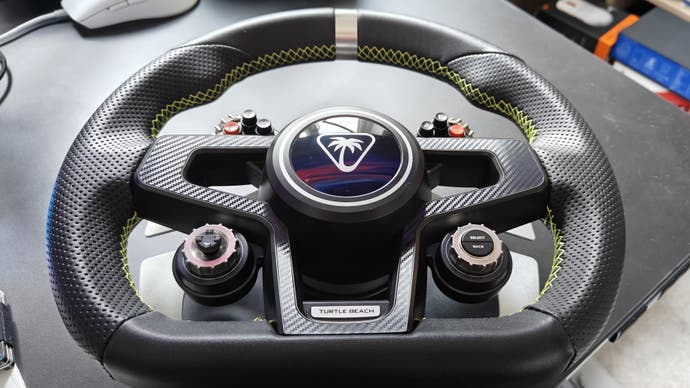
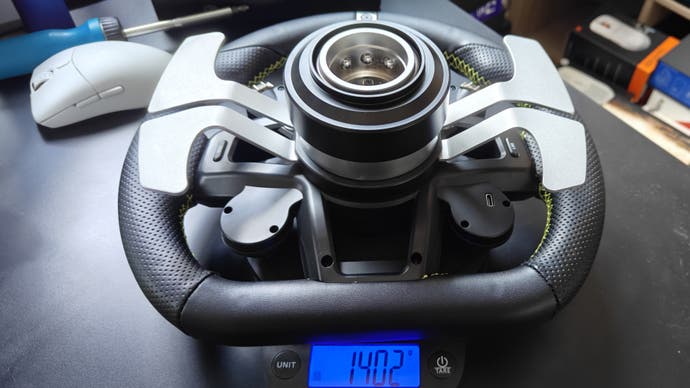
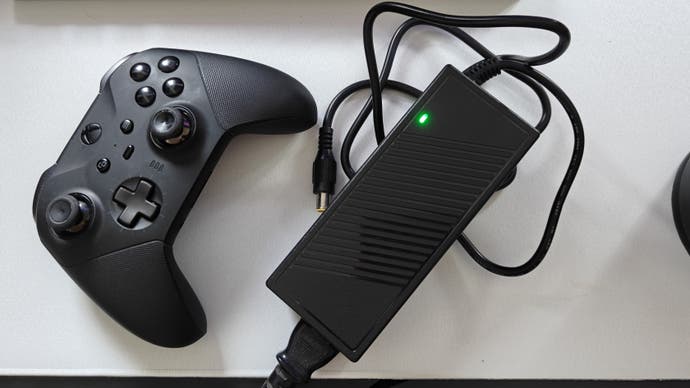

The control unit is at least attractively designed, with four tri-position switches, four red buttons, three dials and three further buttons at the top - two for turning the wheelbase on and off and a third protected switch you can bind to something cool (like NOS).
However, there are quite a few oddities here as well, most notably the fact that the switches at the bottom only recognise an input when they move from the top position to the middle position - so going middle to top, middle to bottom and bottom to middle does nothing, calling into question why Turtle Beach's designers opted for a three-position switch in the first place. The unit is also a bit wobbly even when fully bolted in, which isn't a usability concern but doesn't make for the best first impression.
I'm also not fully onboard with the wheel off button being close to the rightmost dial, as it's easy to brush accidentally while wearing gloves and turns off the wheel immediately. There is another button on the side of the wheelbase that can turn it off, so it would have been nice if these buttons, labelled 'engine off' and 'engine on', could have actually been bound to these functions in-game.
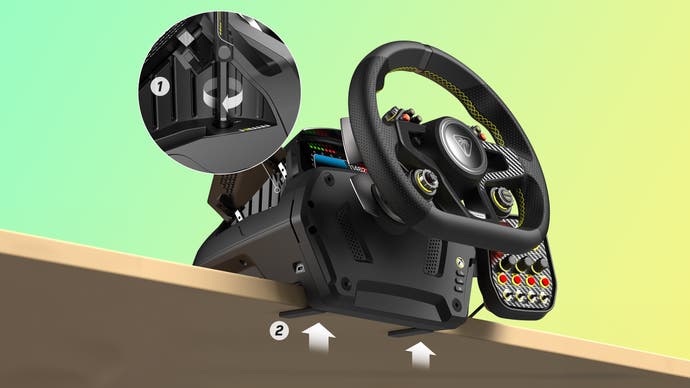
As well as physically mounting the wheel and pedals, you'll need to set up the software side of things. The Tuner app is available for Windows and Xbox, and a mobile version exists although I couldn't get it to work. On Windows, it prompted me to do a firmware update for the display and the base itself, which required me to first unplug the pedals (a curiosity of this particular patch) and then manually start each of the two updates. These took over 20 minutes each, so after leaving to eat dinner I came back to find that I was only halfway through the process.
Turtle Beach representatives told me that they split the updates in order to be able deliver system updates more quickly without having to go through the longer display firmware update process, which is reasonable - but the app ought to automatically apply these updates in sequence if multiple patches are available. This is how it works in other ecosystems (Moza, Fanatec, Logitech) and ought to be achievable by Turtle Beach as well. I also noted when updating my Moza R9 bundle (review to come!) that updating multiple components only took only a couple of minutes in total, which suggests that the VelocityOne Race's update process might have a hardware limitation (USB bandwidth? Controller performance?) or software refinements might be possible - hopefully the latter.
I did appreciate that, after updating the firmware, plenty of changes could be made on the wheel itself within a few moments, taking full advantage of the large colour display. This makes things quite intuitive versus trying to guess what abbreviated words on a tiny OLED screen, though I would have appreciated slightly fewer branded setting names (K-Drive! RMD! VCU!) in favour of more descriptive language. There is at least a nice product guide that explains each option in some detail. You'll also need to rely on TB's documentation to see which games support live telemetry, and I found that even recent games like F1 23 required every key to be bound manually, versus Moza and Logitech which had premade profiles available.
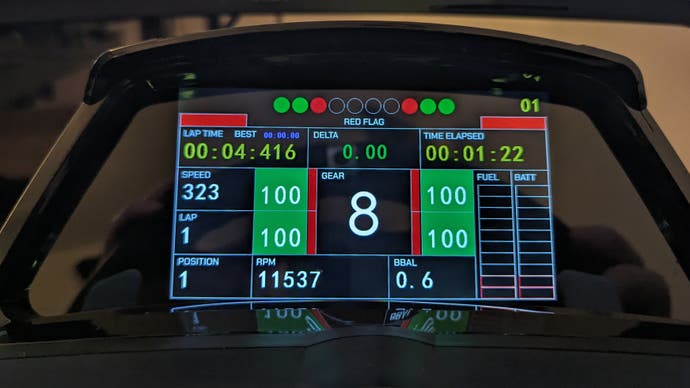
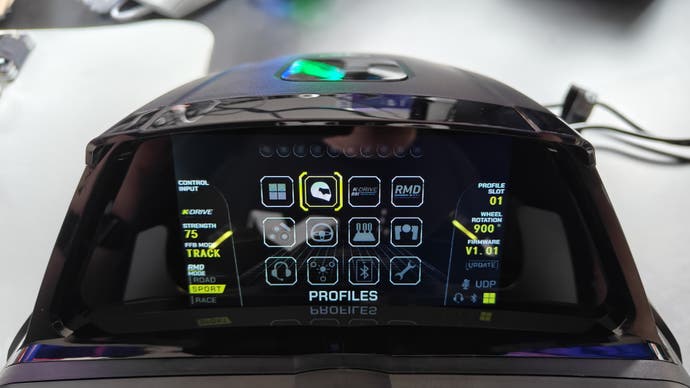
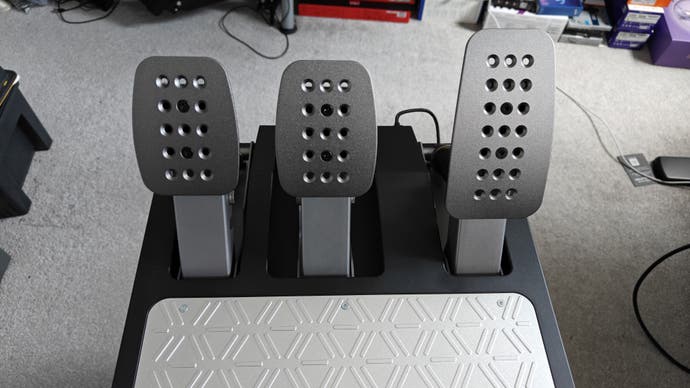
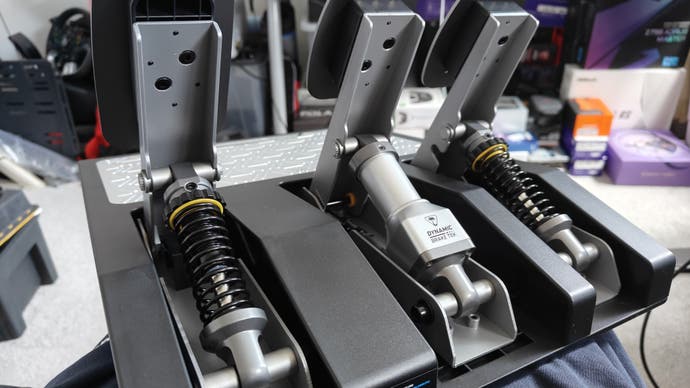
Once finally set up and ready to go though, I found the VelocityOne Race quite capable in-game. There's perhaps a little less detail in the force feedback compared to more established rivals like Moza or Logitech, but this direct drive wheel is still powerful at 7.2Nm and the feedback is much more immediate than cheaper belt or gear-driven alternatives, like Logitech's G29 or G923.
I did find the return-to-centre setting a bit strong at first, but after adjusting it to 25 percent it felt much like other wheels. Overall, I was within a few tenths of the times I was setting in F1 23 with more expensive setups (eg Logitech's Pro Racing wheel and pedals, Moza's R9 V2 and R9 V2 and GS V2P GT bundle and SR-P pedals), which was close enough for my purposes.


Having the screen is also quite convenient, as in addition to things like gears and speed, you can see more fine-grained information like tyre temperature and brake balance settings without having to switch to particular panels in-game. I also quite like having the extra buttons on the control pod available for functions like pausing the game or adjusting brake bias, though I still think that having extra controls on the wheel itself is better overall.
The load-cell brake is also impressive, especially when bolted into a sim rig, and makes it easier to brake consistently from lap to lap. The other pedals are less extraordinary, but their positioning and sensitivity felt fine. I did see some flex in the pedal base when stamping the brake, but at least during the weeks that I was testing I didn't observe any damage or other issues as a result of this.
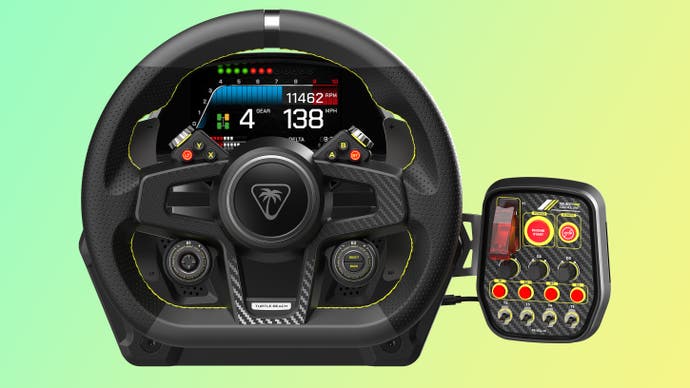
The VelocityOne Race is a good first effort from Turtle Beach overall, with some clever ideas that are largely well-realised, a sensible focus on a more mainstream market and an aggressive (£629/$650) price point for the features provided.
However, like Logitech's G Pro Racing wheel and pedals, you do give up some flexibility by buying into an ecosystem that hasn't been built out with things like alternate wheel rims or extra accessories like shifters, displays, handbrakes and so on - which is a big benefit to going with a brand like Fanatec or Moza.
There are also some smaller issues that I hope can be improved through software updates or hardware revisions - for example, making software updates a speedier or at least single-click affair, providing pre-made profiles for popular games that just work, fixing the control pod to the unit more securely, allowing more of the provided controls to be remapped, and providing more display customisation options. There is at least a solid base here from which Turtle Beach can work, and looking at the company's efforts in other spaces I do have confidence that the Race will be improved over time.
However, it's also obvious that the likes of Moza and Fanatec simply have more polished software and a richly developed hardware ecosystem in the here and now, so it's worth considering their own similarly priced offerings - like Moza's R5 or R9 and Fanatec's Ready2Race CSL DD and GT DD bundles.
Regardless, if you want a streamlined and effective Xbox and PC setup with everything you need to go racing in one box, Turtle Beach's VelocityOne Race is worth considering against its better-known opposition.
